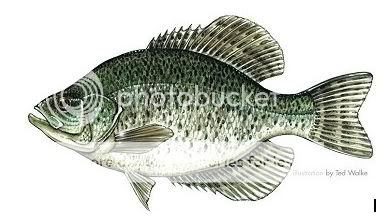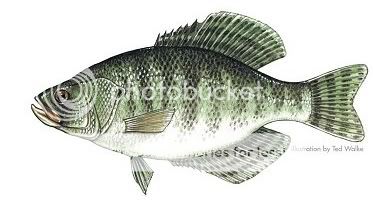
BLACK CRAPPIE
Scientific Name: Pomoxis nigromaculatus
Other Common Names: speckled perch, calico bass, papermouth
Identification: With a compressed body, small head and arched back, the black crappie is silvery-green to yellowish, with large dorsal and anal fins of almost identical shape and size. It has a large mouth with an upper jaw extending under the eye. It has many dark spots on its sides and fins, which become more mottled toward the back. To differentiate between a black crappie and a white crappie, count the dorsal spines. The black crappie has seven to eight dorsal spines, while the white crappie has only five to six.
Habitats and Habits: Black crappie are thought to be native to North Carolina and have been widely stocked across the state. They thrive in clear ponds, natural lakes and reservoirs with moderate vegetation. Black crappie are also common in large, slow-moving rivers in the Coastal Plain but will avoid areas that are turbid or murky.
Young black crappie prey on insects, plankton and larval fishes. Adult black crappie eat mainly fish, but they will also eat aquatic organisms and terrestrial insects.
Fishing Techniques: Effective bait and lures are small jigs, minnows, silver spoons, flies and spinners fished along shorelines, around submerged brush piles and near fallen trees. Fishing vertically is effective when black crappie are deep enough to tolerate a boat directly overhead. Drifting or trolling with jigs works well when crappie are roaming open waters. To attract black crappie, anglers will often sink fish hides or “hurdles” consisting of Christmas trees and other woody debris.
--------------------------------------------------------------------------------------------------------------------------------------------------------

WHITE CRAPPIE
Scientific Name: Pomoxis annularis
Other Common Names: speckled perch, silver bass, papermouth
Identification
The white crappie has a compressed, deep-silvery body, with shades of green or brown on its back. It has five to 10 dark vertical bars on each side and a whitish belly. It is “hump-backed” with five or six spines in the dorsal fin. The dorsal fin, anal fin and tail contain a combination of dark spots and bands.
Habitats and Habits
Although widely stocked across the state, white crappie are not native to North Carolina and were most likely introduced in the late 1800s. Some of the best white crappie populations are found in Piedmont reservoirs, rivers and large ponds. White crappie are apparently intolerant of acidic waters and are virtually absent from the Coastal region.
White crappie seem to thrive in warmer and more turbid waters than black crappie. They are closely associated with structure, often found near fallen trees, stumps, docks and thick stands of aquatic vegetation.
Small white crappie feed mainly on insects, freshwater shrimp and nymphs, while larger crappie prefer small fish and larger insects. They are especially active at sunrise, sunset and at night during the summer months.
Fishing Techniques
White crappie bite best on live minnows, small jigs and spinners. The best time to fish for white crappie is during the spring spawning season when fish move into shallow shoreline areas. Anglers should concentrate on areas with brush, stumps and docks. To concentrate crappie, anglers will often make “crappie attractors” by sinking Christmas trees and other woody debris. During summer and early fall, reservoir crappie move into deeper water along creek channels, roadbeds and submerged points. The fall can be another hot fishing time for crappie as they move inshore again for a short time.
